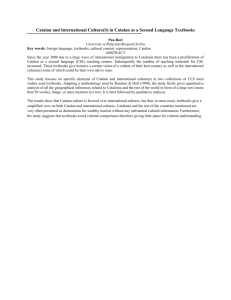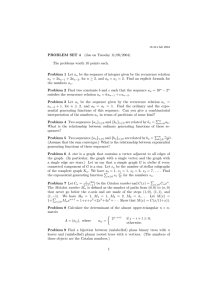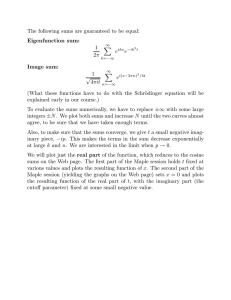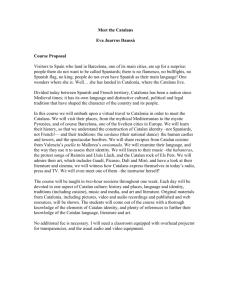DERIVATIVES OF CATALAN RELATED SUMS ANTHONY SOFO
advertisement
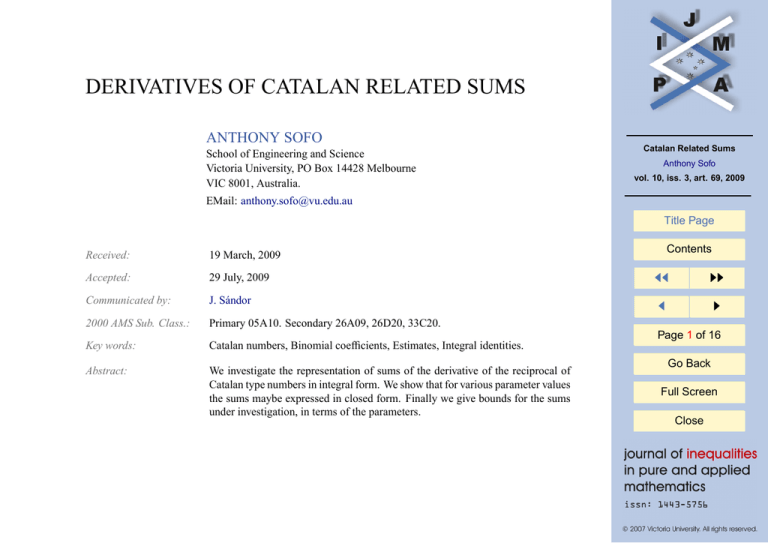
DERIVATIVES OF CATALAN RELATED SUMS
ANTHONY SOFO
School of Engineering and Science
Victoria University, PO Box 14428 Melbourne
VIC 8001, Australia.
Catalan Related Sums
Anthony Sofo
vol. 10, iss. 3, art. 69, 2009
EMail: anthony.sofo@vu.edu.au
Title Page
Received:
19 March, 2009
Accepted:
29 July, 2009
Communicated by:
J. Sándor
2000 AMS Sub. Class.:
Primary 05A10. Secondary 26A09, 26D20, 33C20.
Key words:
Catalan numbers, Binomial coefficients, Estimates, Integral identities.
Abstract:
We investigate the representation of sums of the derivative of the reciprocal of
Catalan type numbers in integral form. We show that for various parameter values
the sums maybe expressed in closed form. Finally we give bounds for the sums
under investigation, in terms of the parameters.
Contents
JJ
II
J
I
Page 1 of 16
Go Back
Full Screen
Close
Contents
1
Introduction
3
2
Catalan Related Sums
7
Catalan Related Sums
Anthony Sofo
vol. 10, iss. 3, art. 69, 2009
Title Page
Contents
JJ
II
J
I
Page 2 of 16
Go Back
Full Screen
Close
1.
Introduction
We define Cn (j) , the Catalan related numbers, for j ∈ N ∪ {0} , N = {1, 2, 3, ...}
as
1 2n+j 2n+j+1
1
, for n = 1, 2, 3, ...
n+1 n = 2n+j+1
n+1
(1.1)
Cn (j) =
1,
for n = 0,
and in particular, from (1.1), the Catalan numbers Cn = Cn (0) are defined by
1 2n 2n+1
1
, for n = 1, 2, 3, ...
n+1 n = 2n+1
n
.
Cn =
1,
for n = 0.
Catalan numbers have many representations, see Adamchik [1], in particular Penson and Sixdeniers [3], by employing some ideas of the Mellin transform gave the
integral representation,
Z 4
√
1
(1.2)
Cn =
tn−1/2 4 − t dt.
2π 0
By the change of variable tw2 = 4 − t, in (1.2) we find that
Z
22n+2 ∞
w2
Cn =
dw,
π
(1 + w2 )n+2
0
which, see Bailey et.al. [2], is closely related to cbn , the central binomial coefficient
Z
2n
22n+1 ∞
1
cbn =
=
dw.
n
π
(1 + w2 )n+1
0
Moreover, it can be seen that cbn = (n + 1) Cn .
Catalan Related Sums
Anthony Sofo
vol. 10, iss. 3, art. 69, 2009
Title Page
Contents
JJ
II
J
I
Page 3 of 16
Go Back
Full Screen
Close
Lemma 1.1. For j ≥ 0 and n ∈ N, let the Catalan related numbers
1 2n+j 2n+j+1
1
, for n = 1, 2, 3, ...
n+1 n = 2n+j+1
n+1
Cn (j) =
1,
for n = 0
be an analytic function in j then
0
1
1
d
(1.3)
=
dj Cn (j)
Cn (j)
n
n+1 X
= − 2n+j n
=−
r=1
Catalan Related Sums
Anthony Sofo
vol. 10, iss. 3, art. 69, 2009
1
r+j+n
Title Page
n+1
2n+j [Ψ (1 + j + 2n) − Ψ (1 + j + n)] ,
n
where the Psi(or digamma function)
0
Ψ (z) =
(Γ (z))
d
ln (Γ (z)) =
dz
Γ (z)
Contents
JJ
II
J
I
Page 4 of 16
Go Back
and the Gamma function
Z
Γ (w) =
w−1 −t
t
0
for < (w) > 0.
Full Screen
∞
e
dt,
Close
Proof. For the first derivative of
1
Cn (j)
with respect to j, let for integer n,
1
n+1
= 2n+j Cn (j)
n
(n + 1) Γ (n + 1) Γ (n + j + 1)
Γ (2n + j + 1)
(n + 1) Γ (n + 1)
= Q
.
n
(n + r + j)
=
r=1
Taking the logs on both sides we have
" n
#
X
1
ln
= ln (n + 1) + ln [Γ (n + 1)] − ln
(n + r + j)
Cn (j)
r=1
and differentiating with respect to j we obtain the result (1.3).
It may be seen that for j = 0, we obtain
0 n
i
1
n+1X 1
n + 1 h (1)
(1)
= − 2n = − 2n H2n+1 − Hn+1 ,
Cn (j)
r+n
j=0
n
n
r=1
Catalan Related Sums
Anthony Sofo
vol. 10, iss. 3, art. 69, 2009
Title Page
Contents
JJ
II
J
I
Page 5 of 16
Go Back
th
where the n Harmonic number
Z 1
n
X
1 − tn
1
(1)
Hn = Hn =
dt =
= γ + Ψ (n + 1) ,
r
t=0 1 − t
r=1
and γ denotes the Euler-Mascheroni constant, defined by
!
n
X
1
γ = lim
− log (n) = −Ψ (1) ≈ 0.577215664901532860606512.........
n→∞
r
r=1
Full Screen
Close
An extension of the nth harmonic numbers is introduced and studied by Sandor [4].
As an aside it is possible to consider higher derivatives of (1.3).
Some numbers of (1.3), without the negative sign are
0
1
n
Cn (j)
2
1
2
(j+2)
3!(2j+7)
2
(j+3)2 (j+4)2
2 +30j+74
4!
3j
(
)
3
(j+4)2 (j+5)2 (j+6)2
3
2
5!(2j +39j +251j+533)
4
2
2
2
2
(j+5)
(j+6)
(j+7)
(j+8)
4
3
2
6!
5j
+160j
+1905j
+10000j+19524
(
)
5
2
2
2
2
2
(j+6) (j+7) (j+8) (j+9) (j+10)
5
4
3
2
7!(6j +285j +5380j +50445j +234908j+434568)
6
(j+7)2 (j+8)2 (j+9)2 (j+10)2 (j+11)2 (j+12)2
...
.............................
Catalan Related Sums
Anthony Sofo
vol. 10, iss. 3, art. 69, 2009
Title Page
Contents
JJ
II
J
I
Page 6 of 16
Go Back
Full Screen
In the next theorems we give integral representations for various summation expressions of Catalan type numbers with parameters. In some particular cases we give
closed form values of the sums and then determine upper and lower bounds in terms
of the given parameters.
The following theorem is proved.
Close
2.
Catalan Related Sums
Theorem 2.1. Let the
Catalan related numbers, with parameter j = 0, 1, 2, 3, 4, ...,
2n+j
1
Cn (j) = n+1 n and |t| < 4, then
Sj (t) =
∞
X
n=1
n
tn X
1
Cn (j) r=1 r + j + n
∞ n
n
X
t (n + 1) X
=
2n+j
n
n=1
r=1
Catalan Related Sums
1
r+j+n
Anthony Sofo
vol. 10, iss. 3, art. 69, 2009
∞ n
X
t (n + 1)
[Ψ (1 + j + 2n) − Ψ (1 + j + n)]
=
2n+j
Z
= −2t
(2.1)
0
1
Contents
(1 − x)j+1 log(1 − x)
dx.
(1 − tx (1 − x))3
Proof. Consider
∞
X
n=1
Title Page
n
n=1
=
n=1
Γ (2n + j + 1)
II
J
I
Page 7 of 16
∞
X tn (n + 1)
tn
=
2n+j
Cn (j) n=1
n
∞ n
X
t (n + 1) Γ (n + 1) Γ (n + j + 1)
JJ
Go Back
.
Now by the use of the Gamma property Γ (n + 1) = nΓ (n) we have
∞ n
∞
X
t n (n + 1) Γ (n) Γ (n + j + 1) X n
=
t n (n + 1) B (n, n + j + 1) ,
Γ
(2n
+
j
+
1)
n=1
n=1
Full Screen
Close
where
Γ (α) Γ (β)
Γ (α + β + 1)
Z 1
=
(1 − y)α−1 y β−1 dy
Z0 1
=
(1 − y)β−1 y α−1 dy
B (α, β) =
Catalan Related Sums
Anthony Sofo
0
vol. 10, iss. 3, art. 69, 2009
for α > 0 and β > 0 is the classical Beta function, therefore
Z 1
∞
∞
X
X
n
n
t n (n + 1) B (n, n + j + 1) =
t n (n + 1)
(1 − x)n+j xn−1 dx
n=1
n=1
1
Z
=
0
Title Page
0
j
(1 − x)
x
∞
X
Contents
n
n (n + 1) (tx (1 − x)) dx
n=1
by interchanging sum and integral. Now applying Lemma 1.1 we obtain
Z 1
(1 − x)j+1 log(1 − x)
Sj (t) = −2t
dx,
(1 − tx (1 − x))3
0
JJ
II
J
I
Page 8 of 16
Go Back
Full Screen
which is the result (2.1).
Close
Other integral representations involving binomial coefficients and Harmonic numbers can be seen in [5], [6], [7] and [8].
Remark 1. For j ∈ N we obtain for t = 2
n
∞
X
2n (n + 1) X
Sj (2) =
2n+j
n
n=1
1
r=1
j+1
1
r+j+n
(1 − x) log(1 − x)
dx
(1 − 2x (1 − x))3
0
= α1 G + α2 ζ (2) + α3 π ln (2) + α4 π + α5 ,
Z
= −4
where the Catalan constant
Z
G=
Catalan Related Sums
Anthony Sofo
vol. 10, iss. 3, art. 69, 2009
π
4
ln (cot (x)) dx = .0.91596559...,
0
and ζ (z) is the Zeta function. Some specific cases of Sj (2) are
j
α1
α2
α3
α4
α5
1
3
3
0
0
0
4
4
3
27
3
7
7
6
−
−
8
32
32
32
4
35
27
35
3
6920563
13
−
−
−
32
256
128
32
6350400
....... ....... ....... ....... .......
.......
Remark 2. For j ∈ N we obtain for t = − 12
n
X
∞
n
− 12 (n + 1) X
1
1
=
Sj −
2n+j
2
r+j+n
n
n=1
r=1
Title Page
Contents
JJ
II
J
I
Page 9 of 16
Go Back
Full Screen
Close
Z
=
0
1
(1 − x)j+1 log(1 − x)
3 dx
1 + 12 x (1 − x)
= β1 ζ (2) + β2 (ln (2))2 + β3 ln (2) + β4 .
Some specific cases of Sj − 21 are
j
β1
β2
β3
β4
8
4
2
− 81
−
0
0
81
27
8
8
4
2
2
− 81 − 27 − 9
81
.
8 − 31412 31744 6596 5045
81
81
27
18
. . .
...
...
... ...
Catalan Related Sums
Anthony Sofo
vol. 10, iss. 3, art. 69, 2009
Title Page
Contents
Next we shall give upper and lower bounds for the series Sj (t) given by (2.1).
Theorem 2.2. For j = 0, 1, 2, 3, ..., and 0 < t < 4
2t
(2.2)
< Sj (t)
(j + 2)2
2t
4 3
,
2
4−t
(j+2)
≤
q
4
3
2 −1490t+3860
2
+
2t (2j+3)3 2t −41t +342t
5(4−t)5
Proof. Consider the integral inequality
Z x1
Z
|f (x) g (x)| dx ≤ sup |f (x)|
x0
x∈[x0 ,x1 ]
II
J
I
Page 10 of 16
Go Back
Full Screen
1008 arcsin
√
√ 1
t
2
t(4−t)11
x1
x0
JJ
|g (x)| dx,
Close
2
.
and from the integral (2.1) we can identify
Z x1
Z 1
(2.3)
|g (x)| dx =
(1 − x)j+1 ln (1 − x) dx =
x0
0
1
.
(j + 2)2
Similarly
f (x) =
(2.4)
2t
(1 − tx (1 − x))3
Catalan Related Sums
Anthony Sofo
is monotonic on x ∈ [0, 1] with lim f (x) = 2t, lim f (x) = 0, hence
x→0
x→1
sup f (x) = 2t
x∈[0,1]
vol. 10, iss. 3, art. 69, 2009
4
4−t
3
.
Title Page
Contents
The series (2.1) is one of positive terms and its lower bound is given by the first
term, hence combining these results we obtain the first part of the inequality (2.2).
For the second part of the inequality (2.2), consider the Euclidean norm where for
α = β = 2, α1 + β1 = 1, and for f (x) and g (x) defined by (2.4) and (2.3) respectively
we have that |f (x)|2 and |g (x)|2 are integrable functions defined on x ∈ [0, 1] . From
(2.1) and by Hölder’s integral inequality, which is a special case of the CauchyBuniakowsky-Schwarz inequality,
Z 1
12 Z 1
21
2
2
Sj (t) ≤
|f (x)| dx
|g (x)| dx ,
0
where
Z
1
2
|g (x)| dx
0
21
0
Z
=
0
1
2 12
j+1
=
(1 − x) ln (1 − x) dx
s
2
(2j + 3)3
JJ
II
J
I
Page 11 of 16
Go Back
Full Screen
Close
and
Z
12
1
2
|f (x)| dx
0
√ 12
t
2t4 − 41t3 + 342t2 − 1490t + 3860 1008 arcsin 2
= 2t
+ q
,
11
5 (4 − t)5
t (4 − t)
so that
Catalan Related Sums
s
Sj (t) ≤ 2t
√ 12
1008 arcsin 2t
4
3
2
2
2t
−
41t
+
342t
−
1490t
+
3860
+ q
11
(2j + 3)3
5 (4 − t)5
t (4 − t)
Anthony Sofo
vol. 10, iss. 3, art. 69, 2009
Title Page
and the second part of (2.2) follows.
Remark 3. For a particular value of t and j ≥ 0 we can plot the exact value of Sj (t) ,
(2.1) against the upper bounds from (2.2)
3
2t
4
(2.5)
Aj (t) =
(j + 2)2 4 − t
and
Contents
JJ
II
J
I
Page 12 of 16
Go Back
s
(2.6) Bj (t) = 2t
Full Screen
2
(2j + 3)3
Close
√ 12
t
1008
arcsin
2
2t
−
41t
+
342t
−
1490t
+
3860
.
×
+ q
11
5 (4 − t)5
t (4 − t)
4
3
2
Catalan Related Sums
Anthony Sofo
vol. 10, iss. 3, art. 69, 2009
Title Page
Contents
Figure 1: A plot of Sj (1.5), Aj (1.5) and Bj (1.5) showing the crossover point at about j = 4.5.
Remark 4. For t = 1.5 we have the graph, Figure 1, showing that Bj (1.5) is a
better estimator of Sj (1.5), (the lower curve in Figure 1), than Aj (1.5) up to about
j = 4.5. The exact value of j for a given value of t can be exactly calculated from
(2.5) and (2.6).
The graph in Figure 1 suggests that the sum in (2.1) may be convex. We prove
the convexity of (2.1) in the following theorem.
Theorem 2.3. For j ≥ 0 and 0 < t < 4 the function j 7→ Sj (t), as given in Theorem
2.1 is strictly decreasing and convex with respect to the parameter j ∈ [0, ∞) for
every x ∈ [0, 1] .
JJ
II
J
I
Page 13 of 16
Go Back
Full Screen
Close
Proof. Let
gj (x, t) =
(1 − x)j+1 ln (1 − x)
(1 − tx (1 − x))3
be an integrable function for x ∈ [0, 1] and put
Z 1
Sj (t) = −2t
gj (x, t) dx,
0
Catalan Related Sums
Anthony Sofo
so that
vol. 10, iss. 3, art. 69, 2009
Z
S0 (t) = −2t
1
Z
g0 (x, t) dx = −2t
0
0
1
(1 − x) ln (1 − x)
dx.
(1 − tx (1 − x))3
Applying the Leibniz rule for differentiation under the integral sign, we have that
Z 1
∂
0
Sj (t) =
gj (x, t) dx
0 ∂j
Z 1
(1 − x)j+1 (ln (1 − x))2
= −2t
dx.
(1 − tx (1 − x))3
0
Since j ≥ 0 and 0 < t < 4
(1 − x)j+1 (ln (1 − x))2
> 0 for x ∈ (0, 1) ,
(1 − tx (1 − x))3
then Sj0 (t) < 0, so that the sum in (2.1), is a strictly decreasing sum with respect to
the parameter j for x ∈ [0, 1] .
Title Page
Contents
JJ
II
J
I
Page 14 of 16
Go Back
Full Screen
Close
Now
Sj00
and since
1
∂2
gj (x, t) dx
2
0 ∂ j
Z 1
(1 − x)j+1 (ln (1 − x))3
= −2t
dx,
(1 − tx (1 − x))3
0
Z
(t) =
Catalan Related Sums
j+1
3
(1 − x) (ln (1 − x))
< 0,
(1 − tx (1 − x))3
then Sj00 (t) > 0 so that (2.1) is a convex function for x ∈ [0, 1] .
Anthony Sofo
vol. 10, iss. 3, art. 69, 2009
Title Page
Contents
JJ
II
J
I
Page 15 of 16
Go Back
Full Screen
Close
References
[1] V. ADAMCHIK, Certain series associated with Catalan’s constant, J. Anal. and
Appl., 21(3) (2002), 818–826.
[2] D.H. BAILEY, J.M. BORWEIN, N.J. CALKIN, R. GIRGENSOHN, D.R. LUKE
AND V.H. MOLL, Experimental Mathematics in Action, Wellesley, MA, AK
Peters, 2007.
Catalan Related Sums
Anthony Sofo
[3] K.A. PENSON AND J.M. SIXDENIERS, Integral representations of Catalan and
related numbers, J. Int. Sequences, 4 (2001), Article 01.2.5.
vol. 10, iss. 3, art. 69, 2009
[4] J. SÁNDOR, Remark on a function which generalizes the harmonic series, C. R.
Bulg. Acad. Sci., 41(5) (1988), 19–21.
Title Page
Contents
[5] A. SOFO, Computational Techniques for the Summation of Series, Kluwer Academic/Plenum Publishers, 2003.
JJ
II
[6] A. SOFO, Integral identities for sums, Math. Comm., 13 (2008), 303–309.
J
I
[7] A. SOFO, Integral forms of sums associated with harmonic numbers, Appl.
Math. Comput., 207 (2009), 365–372.
Page 16 of 16
[8] A. SOFO, Some more identities involving rational sums, Appl. Anal. Disc.
Maths., 2 (2008), 56–66.
[9] O. MARICHEV, J. SONDOW AND E.W. WEISSTEIN, Catalan’s Constant, from Mathworld-A Wolfram Web Rescource. http://mathworld.
wolfram.com/CatalansConstant.html
Go Back
Full Screen
Close

